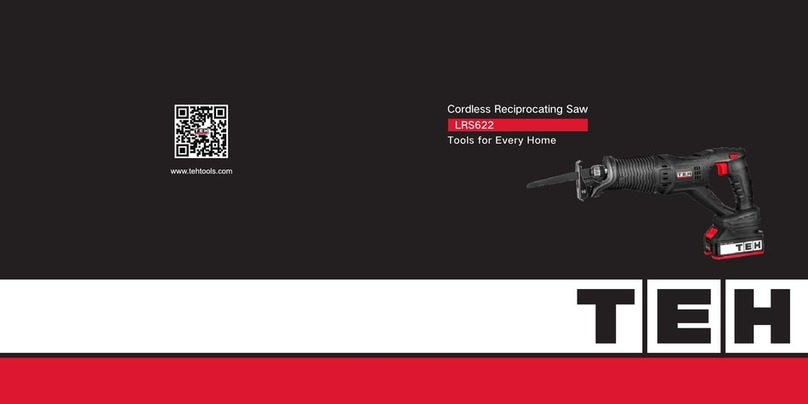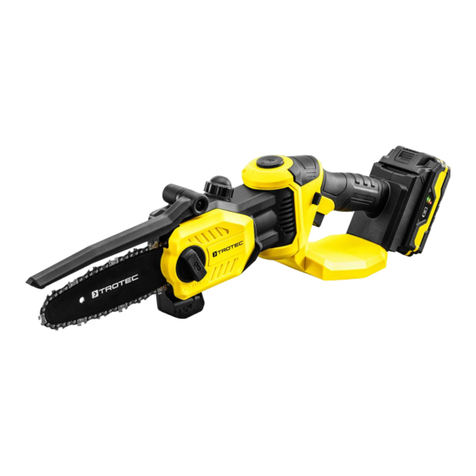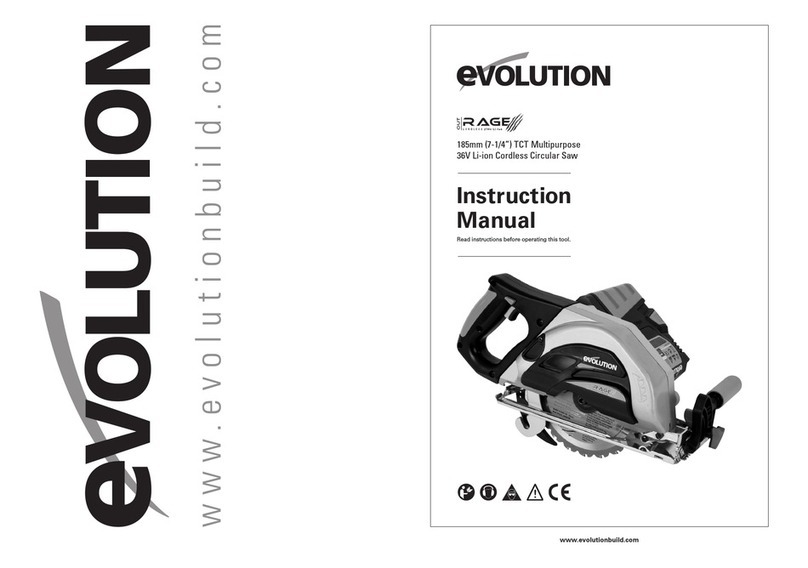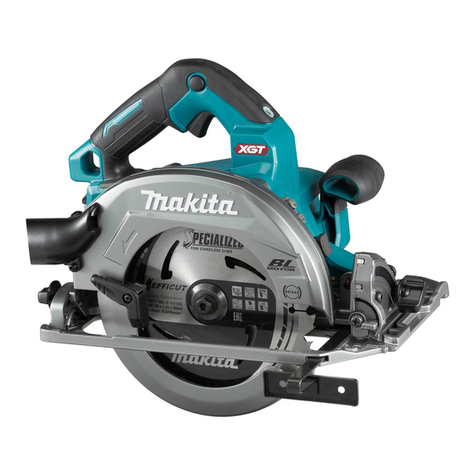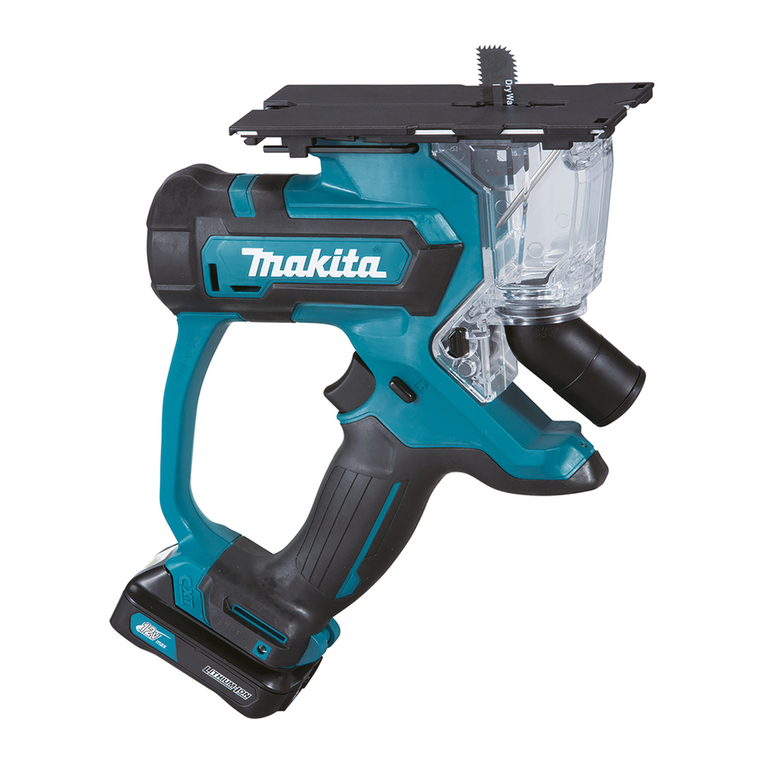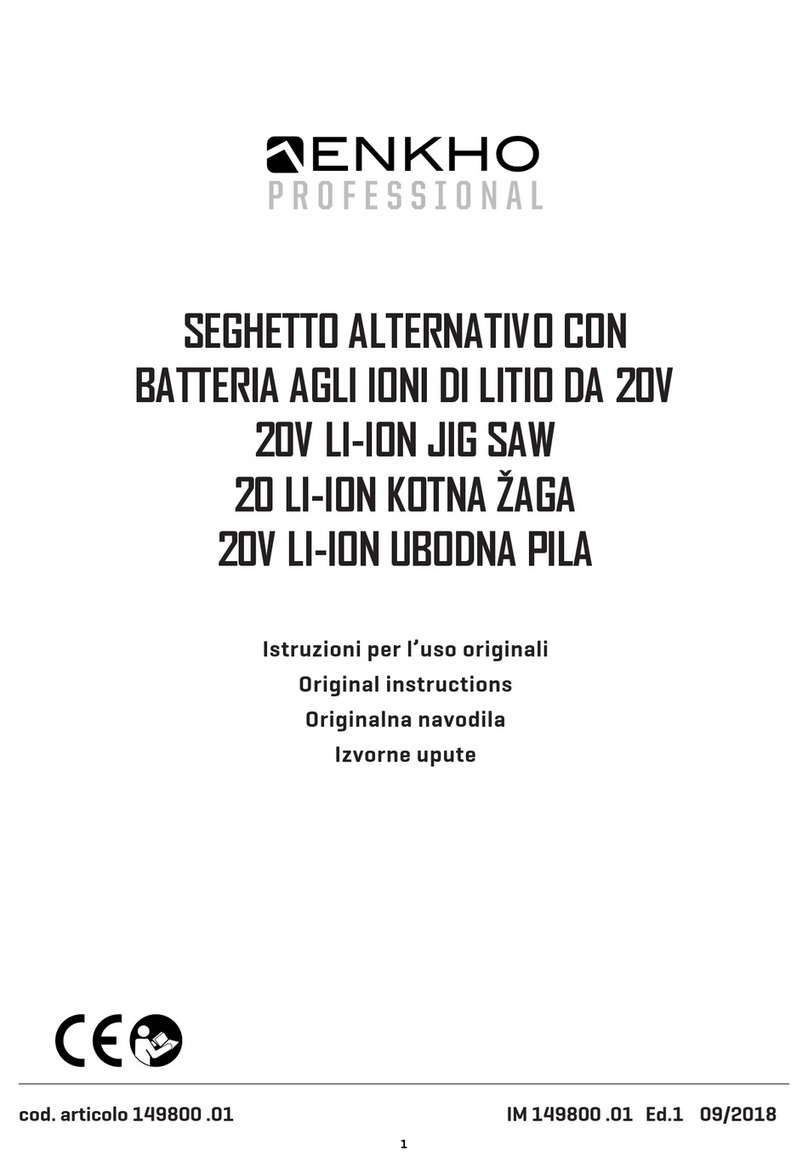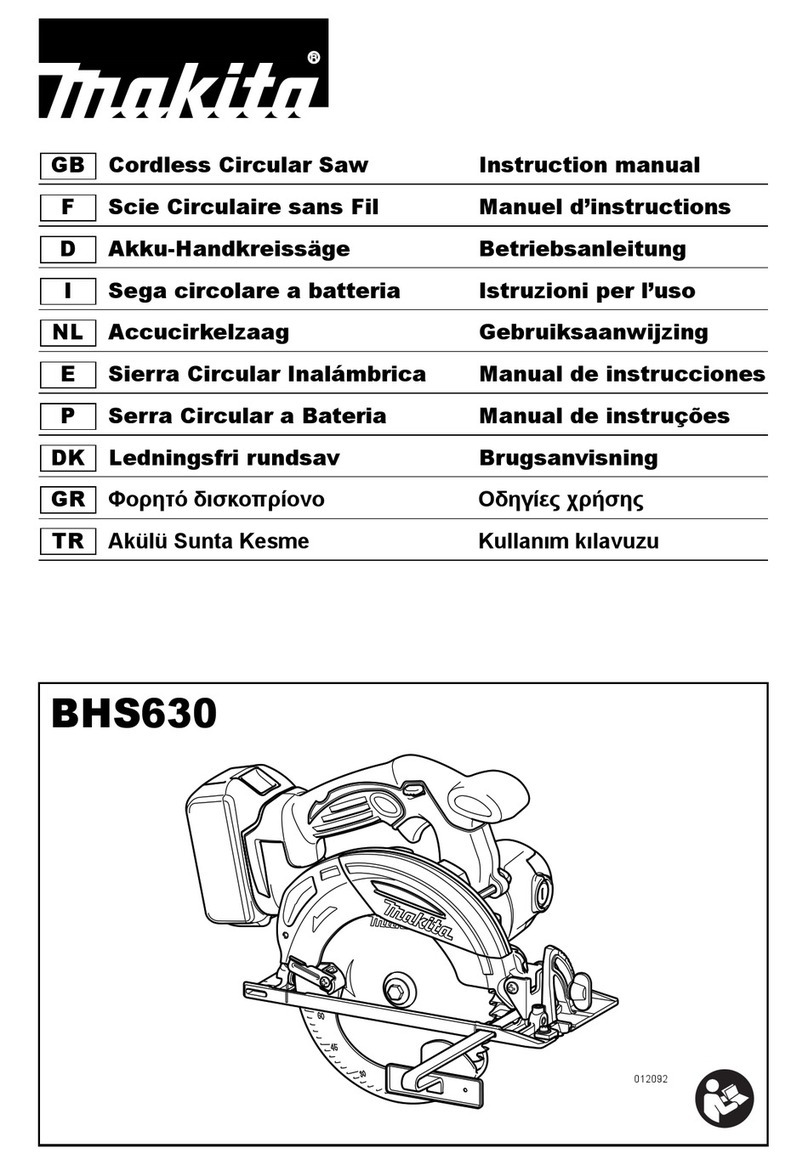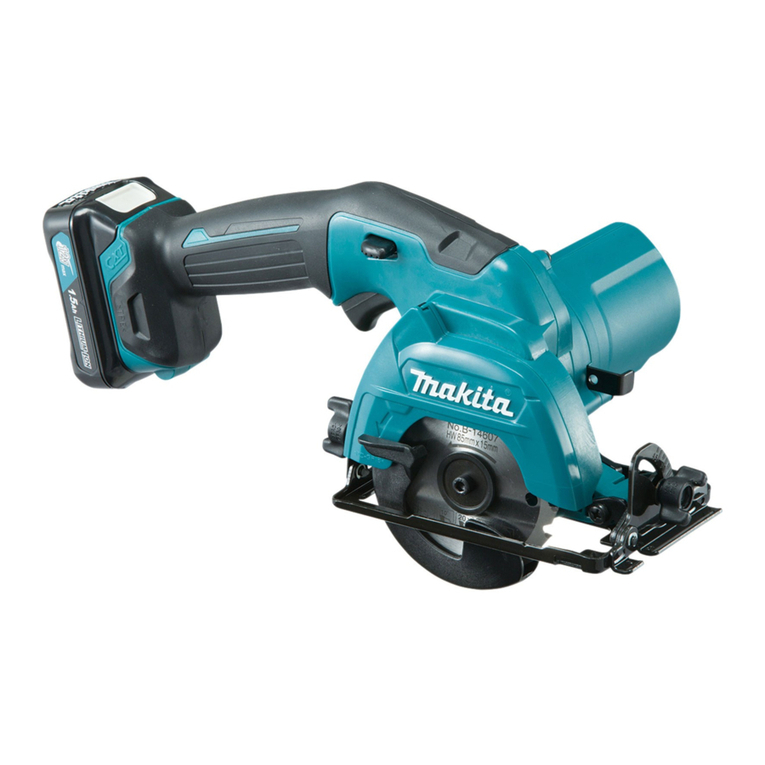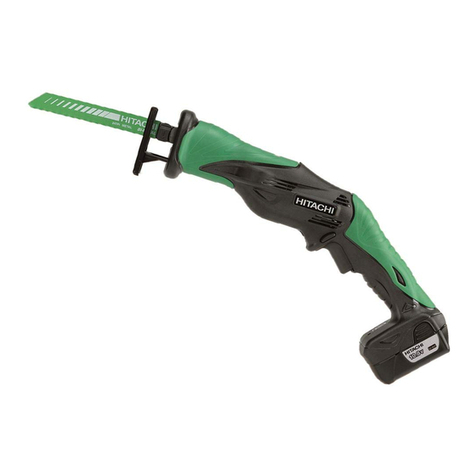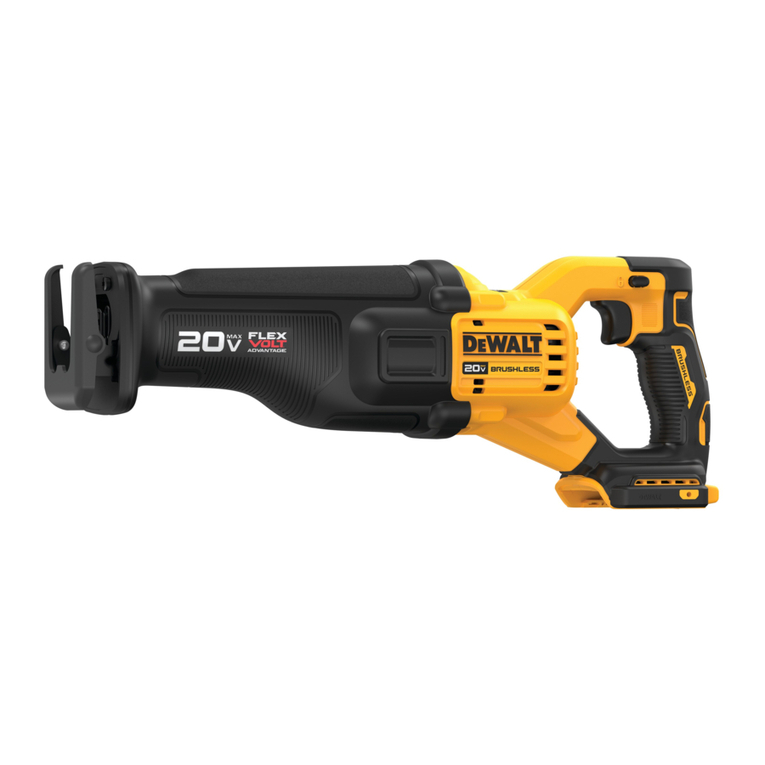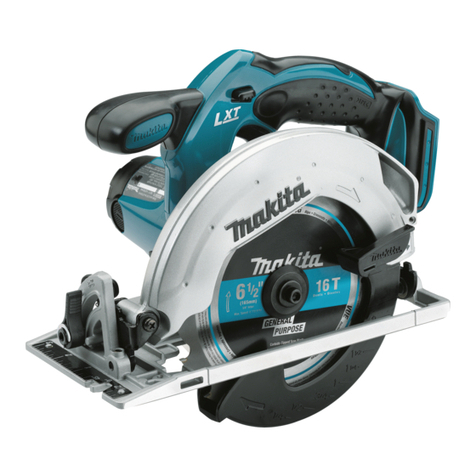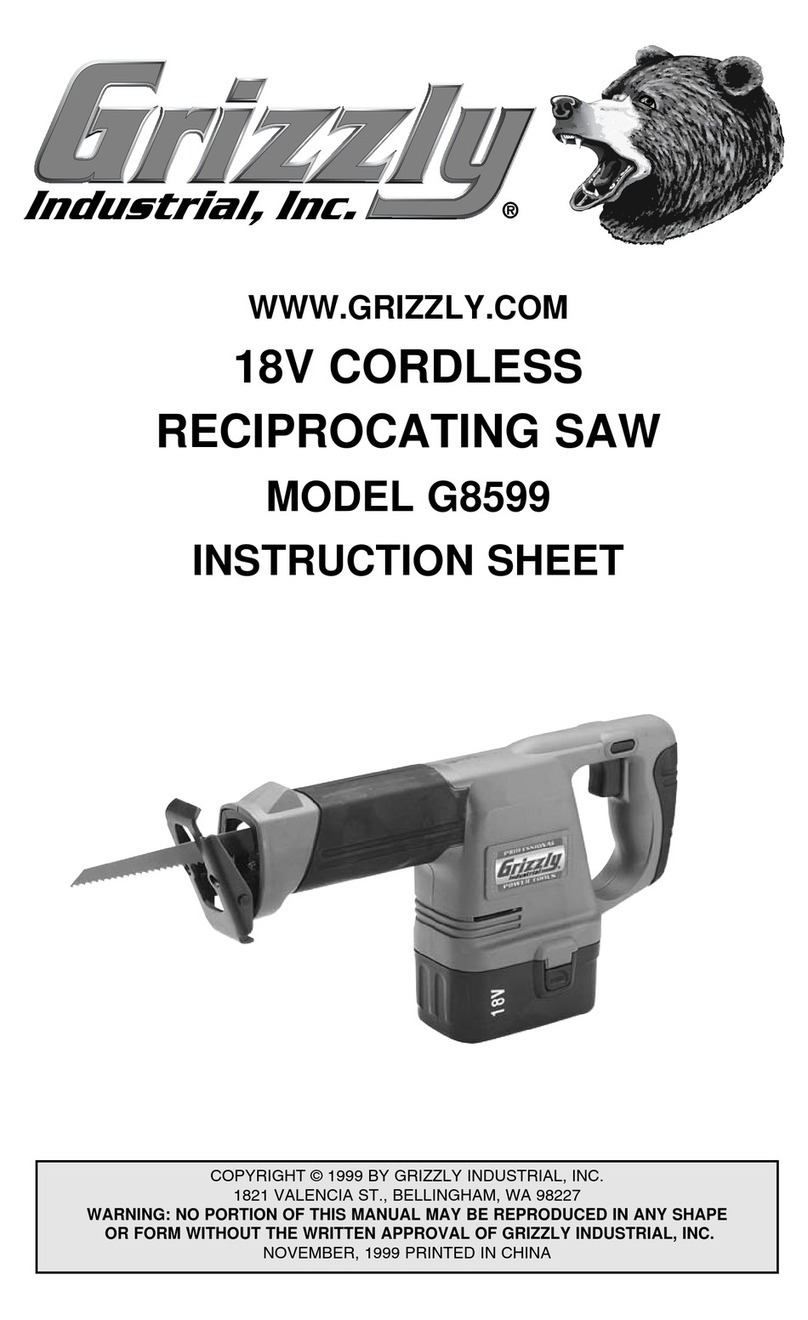TEH LCS165 User manual

Tools for Every Home
Cordless Circular Saw
LCS165

Battery
Release
Button
Battery
On/Off
Switch
Auxialiary Handle
Motor
Housing
Blade Cover
Lock-off Lever
Angle
Adjustment
Depth
Adjustment
12
Model
Motor
No-Load Speed
Rated Voltage
Blade Diameter
Max. Cutting Depth at 0°
at 45° Bevel
Compatible Battery
LCS165
55mm
39mm
Brush
3800r/min
DC 20V
165mm
LB4.0Ah

34
ELECTRICAL SAFETY
a) Power tool plugs must match the outlet. Never modify the plug in any way. Do not use any
adapter plugs with earthed (grounded) power tools. Unmodified plugs and matching outlets will
reduce risk of electric shock.
b) Avoid body contact with earthed or grounded surfaces such as pipes, radiators, ranges and
refrigerators. There is an increased risk of electric shock if your body is earthed or grounded.
c) Do not expose power tools to rain or wet conditions. Water entering a power tool will increase
the risk of electric shock.
d) Do not abuse the cord. Never use the cord for carrying, pulling or unplugging the power tools.
Keep cord away from heat, oil, sharp edges or moving parts. Damaged or entangled cords
increases the risk of electric shock.
PERSONAL SAFETY
a) Stay alert, watch what you are doing and use common sense when operating a power tool. Do
not use a power tool while you are tired or under the influence of drugs, alcohol or medication. A
moment of inattention while operating power tools may result in serious personal injury.
b) Use safety equipment. Always wear eye protection. Safety equipment such as dust mask, non-
skid safety shoes, hard hat, or hearing protection used for appropriate conditions will reduce the
risk of personal injuries.
c) Prevent unintentional starting. Ensure the switch is in the off-position before connecting to
power source and/or battery pack, picking up or carrying the tool.
Carrying power tools with your finger on the switch or energizing power tools that have the switch
on invites accidents.
d) Remove any adjusting key or wrench before turning the power tool on. A wrench or a key to a
rotating part of the power tool may result in personal injury.
e) Do not overreach. Keep proper footing and balance at all times. This enables better control of
the power tool in unexpected situations.
f) Dress properly. Do not wear loose clothing or jewellery. Keep your hair, clothing and gloves
away from moving parts. Loose clothes, jewellery or long hair can be caught in moving parts.
g) Store idle power tools out of the reach of children and do not allow persons unfamiliar with the
power tool or these instructions to operate the power tool. Power tools are dangerous in the hands
of untrained users.
h)Maintain power tools. Check for misalignment or binding of moving parts, breakage of parts
and any other condition that may affect the power tool’s operation. If damaged, have the power
tool repaired before use. Many accidents are caused by poorly maintained power tools.
e) When operating a power tool outdoors, use an extension cord suitable for outdoor use. Use of a
cord suitable for outdoor use reduces the risk of electric shock.
f) If operating a power tool in a damp location is unavoidable, use a residual current device (RCD)
protected supply. Use of an RCD reduces the risk of electric shock.

l) Keep cutting tools sharp and clean. Properly maintained cutting tools with sharp cutting edges
are less likely to bind and are easier to control.
n) Use the power tool, accessories and tool bits etc. in accordance with these instructions, taking
into account the working conditions and the work to be performed. Use of the power tool for
operations different from those intended could result in a hazardous situation.
Have your power tool serviced by a qualified repair person using only identical replacement parts.
This will ensure that the safety of the power tool is maintained.
SERVICE
USE AND HANDLING OF THE CORDLESS
ELECTRICAL POWER TOOL
a) Charge a rechargeable battery unit using only the charger recommended by the manufacturer.
Chargers are often designed for a particular type of rechargeable battery unit. There is the danger
of fire if other types of rechargeable battery units are used.
b) Only the rechargeable battery units supplied are to be used with an electrical power tool. The
use of other rechargeable battery units may lead to the danger of injury or fire.
c) When they are not being used, store rechargeable
battery units away from paperclips, coins, keys, nails, screws or other small metal objects that
could cause the contacts to be bridged. Short-circuiting the contacts of a rechargeable battery
unit may result in heat damage or fire.
d) Fluids may leak out of rechargeable battery units if they are misused. If this happens, avoid
contact with the fluid. If contact occurs, flush the affected area with water. Seek additional medical
help if any of the fluid gets into your eyes. Escaping battery fluid may cause skin irritation or burns.
a) Ensure that the device is switched off before inserting the battery. Inserting a battery into a
power tool that is switched on may result in accidents.
b) Recharge the batteries indoors only because the battery charger is designed for indoor use
only.
c) To reduce the electric shock hazard, unplug the battery charger from the mains before cleaning
the charger.
d) Do not subject the battery to strong sunlight over long periods and do not leave it on a heater.
Heat damages the battery and there is a risk of explosion.
e) Allow a hot battery to cool before charging.
f) Do not open up the battery and avoid mechanical damage to the battery. Risk of short circuit
and fumes may be emitted that irritate the respiratory tract. Ensure fresh air and seek medical
assistance in the event of discomfort.
g) Do not use non-rechargeable batteries!
SPECIAL SAFETY DIRECTIONS FOR BATTERY-OPERATED TOOLS
a) This device can be used by children aged 8 and over and by people with reduced physical,
sensory or mental capacities or with a lack of experience or knowledge, if they are supervised or
have been instructed regarding safe use of the device and understand the resulting risks. Children
are not permitted to play with the device. Cleaning and user maintenance are not to be undertaken
by children without supervision.
b) Children should be supervised to ensure that they do not play with the appliance.
c) To charge the battery, use only the charger supplied. Risk of fire and explosion. This ensures
that the safety of the device is maintained.
d) Before each use, check the charger, cable and plug and have them repaired by qualified
professionals and only with original parts. Do not use a defective charger and do not open it up
yourself. This ensures that the safety of the device is maintained.
CORRECT HANDLING OF THE BATTERY CHARGER
56

e) Connect the charger only to a socket with an earth. Ensure that the mains voltage matches the
specifications on the charger rating plate. Risk of electric shock.
f) Disconnect the charger from the mains before closing or opening connection to the battery /
power tool / device.
g) Keep the charger clean and away from wet and rain. Do not use the charger outdoors. Dirt and
the entry of water increase the risk of electric shock.
h) Operate the charger only with the appropriate original batteries. Charging other batteries may
result in injuries and risk of fire.
I) Avoid mechanical damage to the charger. This can result in internal short circuits.
j) Do not operate the charger on a combustible surface (e.g. paper, textiles). Risk of fire due to
heating during charging.
k) If the power cable for this equipment is damaged, it must be replaced by the manufacturer, a
customer service agent of the same or a similarly qualified person in order to prevent hazards.
l) The battery of the appliance is not fully charged at the time of delivery. It therefore needs to be
fully recharged before you use it for the first time. For the first recharge cycle we recommend that
you charge the battery for about 1 hour. Slot the battery into the base and plug the battery charger
into a mains outlet.
m) When the battery is fully charged, unplug the charger from the mains and from the appliance.
Charging time is approx. 1
hour.
n) Do not charge the battery continuously since this may damage the battery cells.
Note: Repeatedly charging small capacities may damage the battery cells. Recharge the battery
only if the appliance is becoming slow.
o) Do not use the charger to charge non-rechargeable batteries.
Even if properly operating and handling this electric tool, some residual risks will remain. Due to its
construction and build, this electric tool may present the following hazards:
RESIDUAL RISKS
During operation, this electric tool generates an electromagnetic field which, under
certain circumstances, may impair the functionality of active or passive medical
implants. To reduce the risk of serious or lethal injuries, we recommend that persons
with medical implants consult their doctor and the manufacturer of their medical
implant before operating the machine.
WARNING
a) Cuts
b) Ear damage if working without ear protection.
c) Damage to your health caused by swinging your hands and arms when operating the appliance
for longer periods of time or if the unit is not held or maintained properly.
1. Do not reach underneath the workpiece. The guard cannot protect you from the blade below
the workpiece.
2. Adjust the cutting depth to the thickness of the workpiece. Less than a full tooth of the
blade teeth should be visible below the workpiece.
CORDLESS CIRCULAR SAW SAFETY WARNINGS
78
Keep hands away from cutting area and the blade. Keep your second hand on
auxiliary handle, or motor housing. If both hands are holding the saw, they cannot be
cut by the blade.
WARNING

910
3. Never hold the workpiece in your hands or across your
leg while cutting. Secure the workpiece to a stable
platform. It is important to support the work properly to
minimize body exposure, blade binding, or loss of control.
4. Hold the power tool by insulated gripping surfaces, when performing an operation where
the cutting tool may contact hidden wiring.Contact with a“live" wire will also make exposed
metal parts of the power tool“live" and could givethe operator an electric shock.
5. When ripping, always use a rip fence or straight edge guide. This improves the accuracy of
cut and reduces the chance of blade binding.
6. Always use blades with correct size and shape (diamond versus round) of arbor holes.
Blades
that do not match the mounting hardware of the saw will run off-centre. causing loss of control.
7. Never use damaged or incorrect blade washers or bolt. The blade washers and bolt were
specially designed for your saw, for optimum performance and safety of operation.
KICKBACK CAUSES AND RELATED WARNINGS
1. Kickback is a sudden reaction to a pinched, jammed or misaligned saw blade, causing an
uncontrolled saw to lift up and out of the workpiece toward the operator.
2. When the blade is pinched or Jammed tightly by the kerf closing down, the blade stalls and the
motor reaction drives the unit rapidly back toward the operator.
3. If the blade becomes twisted or misaligned in the cut, the teeth at the back edge of the blade
can dig into the top surface of the wood causing the blade to climb out of the kerf and jump back
toward the operator.
Kickback is the result of saw misuse and/or incorrect operating procedures or conditions and can
be avoided by taking proper precautions as given below.
1. Maintain a firm grip with both hands on the saw and position your arms to resist kickback
forces. Position your body to either side of the blade, but not in line with the blade. Kickback
could cause the saw to jump backwards, butkickback forces can be controlled by the operator,if
proper precautions are taken.
2. When blade is binding, or when interrupting a cut for any reason, release the trigger and
hold the saw motionless in the material until the blade comes to a complete stop. Never
attempt to remove the saw from the work or pull the saw backward while the blade is in
motion or kickback may occur. Investigate and takecorrective actions to eliminate the cause of
blade binding.
3. When restarting a saw in the workpiece, center the saw blade in the kerf so that the saw
teeth are not engaged into the material. If a saw blade binds, it may walk up or kickbackfrom
the workpiece as the saw is restarted.
4. Support large panels to minimize the risk of blade pinching and kickback. Large panels
tend to sag under their own weight. Supports must be placed under the panel on both sides,
near the line of cut and near the edge of the panel.
5.Do not use dull or damaged blades. Unsharpenedor improperly set blades produce narrow
kerf caus-ingexcessive friction, blade binding and kickback.

11 12
6. Blade depth and bevel adjusting locking levers must be
tight and secure before making the cut. If blade adjustment
shifts while cutting, it may cause binding and kickback.
7. Use extra caution when sawing into existing walls or
other blind areas. The protruding blade may cut objects that
can cause kickback.
8. ALWAYS hold the tool firmly with both hands. NEVER
place your hand, leg or any part of your body under the
tool base or behind the saw, especially when making
cross-cuts. If kickback occurs, the saw could easily jump
backwards over your hand, leading to serious personal injury.
9. Never force the saw. Push the saw forward at a speed so that the blade cuts without
slowing. Forcing the saw can cause uneven cuts, loss of accuracy, and possible kickback.
LOWER GUARD FUNCTION
5. To check lower guard, open lower guard by hand, then release and watch guard closure.
Also check to see that retracting handle does not touch tool housing. Leaving blade exposed is
VERY DANGEROUS and can lead to serious personal injury.
1. Check the lower guard for proper closing before each use. Do not operate the saw if the
lower guard does not move freely and close instantly. Never clamp or tie the lower guard into
the open position. If the saw is accidentally dropped, the lower guard may be bent. Raise the
lower guard with the retracting handle and make sure it moves freely and does not touch the
blade or any other part, in all angles and depths of cut.
2. Check the operation of the lower guard spring. If the guard and the spring are not operating
properly, they must be serviced before use. Lower guard may operate sluggishly due to
damaged parts, gummy deposits, or a build-up of debris.
3. The lower guard may be retracted manually only for special cuts such as“plunge cuts”
and“compound cuts". Raise the lower guard by the retracting handle and as soon as the
blade enters the material, the lower guard must be released. For all other sawing, the lower
guard should operate automatically.
4. Always observe that the lower guard is covering the blade before placing the saw down on
bench or floor. An unprotected, coasting blade will cause the saw to walk backwards, cutting
whatever is in its path. Be aware of the time it takes for the blade to stop after switch is released.
ADDITIONAL SAFETY WARNINGS
1. Use extra caution when cutting damp wood,
pressure treated lumber, or wood containing knots.
Maintain smooth advancement of tool without decrease
in blade speed to avoid overheatingthe blade tips.
2. Do not attempt to remove cut material when blade is
moving. Wait until blade stops before grasping cut
material. Blades coast after turn off.
3. Avoid cutting nails. Inspect for and remove all nails
from lumber before cutting.
4. Place the wider portion of the saw base on that part
of the workpiece which is solidly supported, not on the
section that will fall off when the cut is made. If the
workpiece is short or small, clamp it down. Do not try
to hold short pieces by hand!
5. Before setting the tool down after completing a cut,
be sure that the guard has closed and the blade has
come to a complete stop.
6. Never attempt to saw with the circular saw held
upside down in a vise. This is extremely dangerous and
can lead to serious accidents.

7. Some material contains chemicals which may be toxic. Take caution to prevent dust
inhalation and skin contact. Follow material supplier safety data.
8. Do not stop the blades by lateral pressure on the saw blade.
9. Do not use any abrasive wheels.
10. Only use the saw blade with the diameter that is marked on the tool or specified in the
manual. Use of an incorrectly sized blade may affect the proper guarding of the blade or guard
operation which could result in serious personal injury.
11. Keep blade sharp and clean. Gum and wood pitch hardened on blades slows saw and
increases potential for kickback. Keep blade clean by first removing it from tool, then cleaning it
with gum and pitch remover, hot water or kerosene. Never use gasoline.
12. Wear a dust mask and hearing protection when use the tool.
13. Always use the saw blade intended for cutting the material that you are going to cut.
14. Only use the saw blades that are marked with a speed equal or higher than the speed
marked
on the tool.
15. (For European countries only)
Always use the blade which conforms to EN847-1.
DO NOT let comfort or familiarity with product (gained from repeated use) replace
strict adherence to safety rules for the subject product. MISUSE or failure to follow
the safety rules stated in this instruction manual may cause serious personal injury.
WARNING
13 14
INSTALLATION INSTRUCTION
Always be sure that the tool is switched off and unplugged before carrying out any
work on the tool.
WARNING
REMOVING OR INSTALLING SAW BLADE
To remove the blade, press the shaft lock so that the blade
cannot revolve and use the wrench to loosen the hex bolt
clockwise.Then remove the hex bolt, outer flange and blade.
1. Be sure the blade is installed with teeth pointing
up at the front of the tool.
2. Use only the TEH wrench to install or remove the
blade.
WARNING
To install the blade, follow the removal procedure in reverse.
Be sure to tighten the hex bolt counter-clockwise
securely.
When changing blade, make sure to also clean upper and
lower blade guards of accumulated sawdust. Such efforts do
not, however, replace the need to check lower guard
operation before each use.
1. Wrench2. Shaft lock
1
2
1. Inner flange 2. Saw blade
3. Outer flange 4. Hex bolt
1
2
3
4

15 16
OPERATION INSTRUCTION
Always be sure that the tool is switched off and unplugged before adjusting or
checking function on the tool.
WARNING
ADJUSTING DEPTH OF CUT
Loosen the clamping screw on the depth guide and move the base up or down. At the desired
depth of cut, secure the base by tightening the clamping screw.
For cleaner, safer cuts, set cut depth so that no more than one blade tooth projects below
workpiece. Using proper cut depth helps to reduce potential for dangerous KICKBACKS which can
cause personal injury.
After adjusting the depth of cut, always tighten the clamping screw securely.
WARNING
BEVEL CUTTING
Loosen the clamping screw on the bevel scale plate on
the front of the base. Set for the desired angle (0° -
45°) by tilting accordingly, then tighten the clamping
screw securely.
1. Bevel scale plate 2. Clamping screw
12
SIGHTING
For straight cuts, align the A position on the front of the
base with your cutting line. For 45° bevel cuts, align the
B position with it. 1
A B
1. Base
SWITCH ACTION
To prevent the switch trigger from being accidentally pulled, a button lock-off button is provided.
To start the tool, push in the lock-off button and pull the switch trigger. Release the switch trigger
to stop.
Before plugging in the tool, always check to see that the switch trigger actuates
properly and returns to the“OFF”position when released.
WARNING

17 18
Be sure to move the tool forward in a straight
line gently. Forcing or twisting the tool will result
in overheating the motor and dangerous
kickback, possibly causing severe injury.
WARNING
Hold the tool firmly. The tool is provided with both a front
grip and rear handle. Use both to best grasp the tool. If
both hands are holding saw, they cannot be cut by the
blade. Set the base on the workpiece to be cut without
the blade making any contact. Then turn the tool on and
wait until the blade attains full speed. Now simply move
the tool forward over the workpiece surface, keeping it
flat and advancing smoothly until the sawing is
completed.
1. Rear handle
2. Front grip
3. Base
1
2
3
To get clean cuts, keep your sawing line straight and your speed of advance uniform. If the cut
fails to properly follow your intended cut line, do not attempt to turn or force the tool back to the
cut line. Doing so may bind the blade and lead to dangerous kickback and possible serious injury.
Release switch, wait for blade to stop and then withdraw tool. Realign tool on new cut line, and
start cut again. Attempt to avoid positioning which exposes operator to chips and wood dust being
ejected from saw. Use eye protection to help avoid injury.
RIP FENCE (GUIDE RULE)
The handy rip fence allows you to do extra-accurate
straight cuts. Simply slide the rip fence up snugly against
the side of the workpiece and secure it in position with
the screw on the front of the base. It also makes
repeated cuts of uniform width possible.
1. Rip fence (Guide rule)
1
MAINTENANCE
Always be sure that the tool is switched off and unplugged before attempting to
perform inspection or maintenance.
WARNING
REPLACING CARBON BRUSHES
Remove and check the carbon brushes regularly.
Replace when they wear down to the limit mark. Keep the
carbon brushes clean and free to slip in the holders. Both
carbon brushes should be replaced at the same time.
Use only identical carbon brushes.
1. Limit mark
1
Use a screwdriver to remove the brush holder caps. Take out the worn carbon brushes, insert the
new ones and secure the brush holder caps.
After replacing brushes, plug in the tool and break in brushes by running tool with no load for
about 10 minutes. Then check the tool while running and electric brake operation when releasing
the switch trigger.
To maintain product SAFETY and RELIABILITY, repairs, any other maintenance or adjustment
should be performed by TEH Authorized or Factory Service Centers, always using TEH
replacement parts.

WARRANTY CARD
ladies/gentlemen: employer:
contact number: fax number:
contact address:
warranty record:
post code:
IMPORTANT NOTE
1. The invoice and warranty card must be presented at the time of warranty.
2. The fuselage number on the invoice is the same as the fuselage number on the warranty card.
3. Once this warranty card is issued, if it is lost, it will not be reissued. Please keep it properly.
Note: The company reserves the right to amend the above provisions and has the final interpretation right in the
case that the warranty service does not violate national laws.
Dear customers, the warranty service for purchasing TEH products is as follows:
Under normal use, within one year from the date of purchase. It is guaranteed that the damage
is caused by the quality of the tool.
The following conditions occur during the warranty period, not covered by the warranty:
a. Any valid legal document (single ticket) certifying the date of purchase
b. Any damage caused by natural wear and overload
c. Any damage caused by the use of low-priced inferior accessories
d. Any damage caused by improper carrying, transportation or storage
e. Any product that has been opened, repaired, replaced, or modified by itself
f. Any damage caused by misuse, beyond the scope of use of the tool,
and failure to use and maintain in accordance with the instructions
19 20
Table of contents
Other TEH Cordless Saw manuals
Popular Cordless Saw manuals by other brands
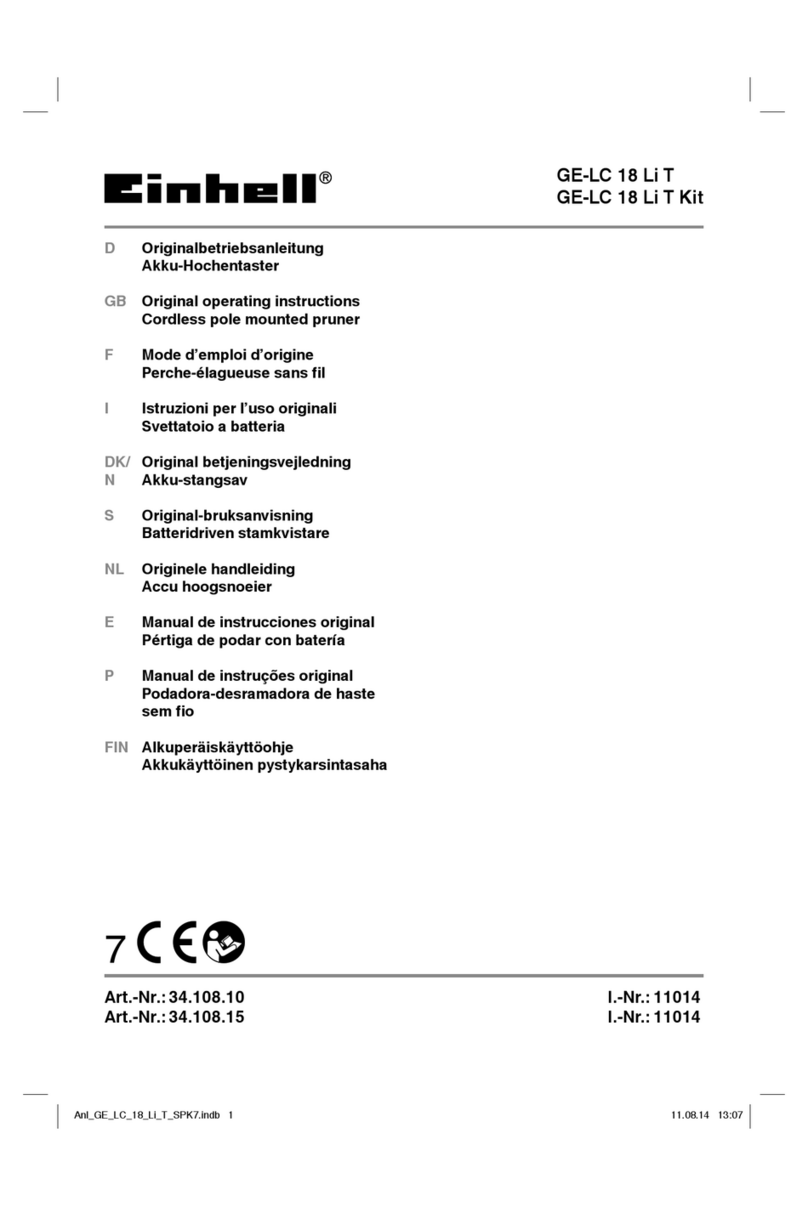
EINHELL
EINHELL GE-LC 18 Li T Original operating instructions
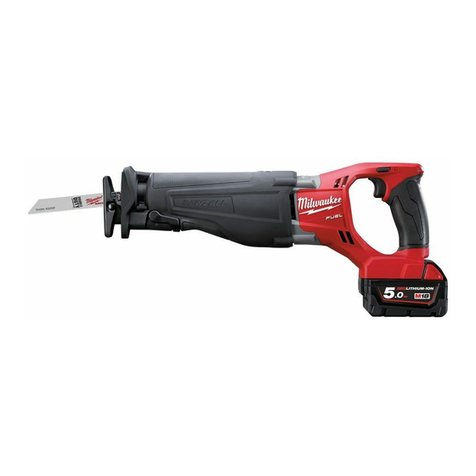
Milwaukee
Milwaukee M18CSX-502X Original instructions

Villager
Villager VLN 1106 Original instruction manual

Mac allister
Mac allister MGS1815-Li manual
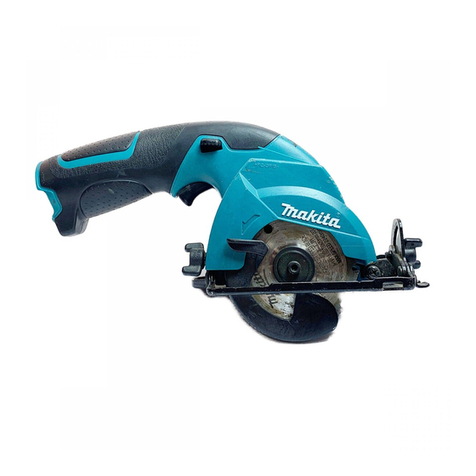
Makita
Makita HS300D instruction manual
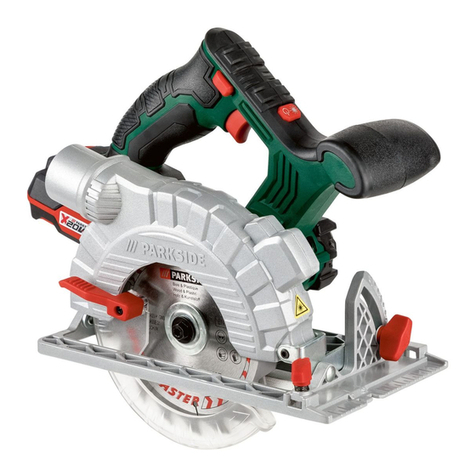
Parkside
Parkside PHKSA 20-Li A2 Translation of the original instructions

